To cut the inner thread on some details, you must pre-drill the hole. Its size is not equal to the diameter of the thread, but should be slightly smaller. You can find the diameter of the drill to the thread in a special table, but for this you need to know the type of thread.
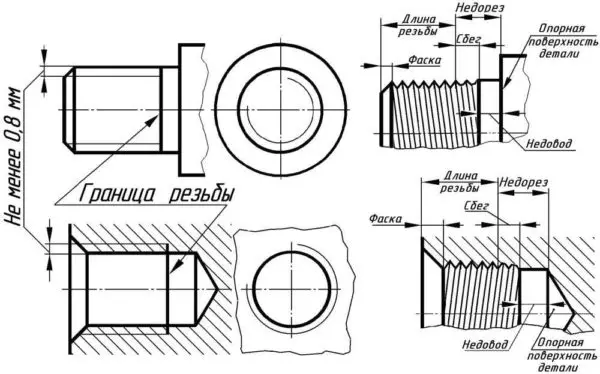
Thread Parameters Determine Drill Diameter
Main settings
Any thread is characterized by two parameters:
- diameter (D);
- Step (P) - distance from one turn to another.
They are determined by GOST 1973257-73. A large step is normal, but it corresponds to some smaller. Small step is used when applied to thin-walled products (pipes with a thin wall). Also make a small twine if the applied thread is a method for adjusting any parameters. Also, a small step between the turns is made to increase the tightness of the compound and to overcome the phenomenon of the removal of the part. In other cases, the standard (large) step is cut.
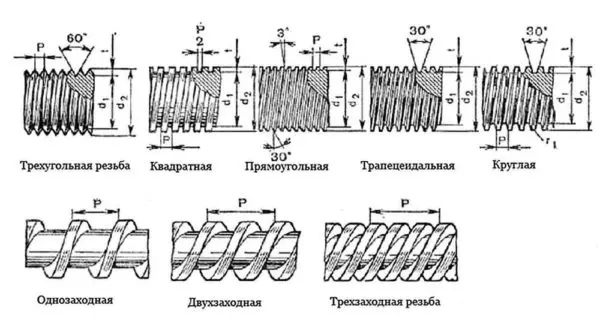
Types of thread and its main characteristics
Threaded types are many, as each has its own features of the formation, the diameter of the thread hole in each case is different. All of them are spelled out in GOST, but most often used triangular metric and conical metric threads. We will talk further about them.
We usually observe triangular threads on bolts and other similar fasteners, conical - on most plumbing products involving a detachable connection.
Fixtures
Small fixtures use with their own hands to apply:
- The dies (they are also called the lars) to apply turns outside (usually on a pipe or metal rod (pin);
- Taps - for internal (here they are predetermined to do the hole).
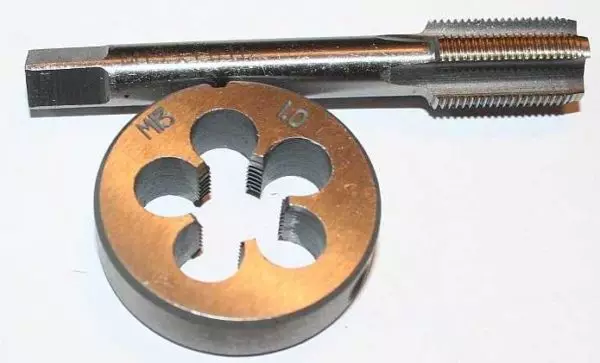
Tap (top) and a dice (below)
All these fixtures of alloys, characterized by increased strength and abrasion resistance are performed. Grooves and grooves are applied on their surface, with which their mirror image is obtained on the workpiece.
Any tap or dice are marked - an inscription is applied on them, which denotes the type of thread that this device cuts - diameter and step. They are inserted into holders - groves and plastics holders - secure there with screws. Climbing the carving device in the holder, it is worn / insert into the place where you want to make a detachable connection. Scrolling the device form the coils. From how correctly the device is put up at the beginning of work depends evenly "ilut" the turns. Because the first revs do trying to keep the design smoothly, not allowing shifts and distortions. After several revolutions are made, the process will go easier.
Manually you can cut the thread of small or medium diameter. Complex types (two- and three-way) or work with large diameters with hands is impossible - too large efforts are required. For these purposes, special mechanized equipment is used - on the lathes with the tags and dies fixed on them.
How to chop correct
You can apply the thread into almost any metals and their alloys - steel, copper, aluminum, cast iron, bronze, brass, etc. It is not recommended to do it on a calene gland - it is too tough, it will not be possible to make high-quality turns to achieve high-quality turns, which means that the connection will be unreliable.
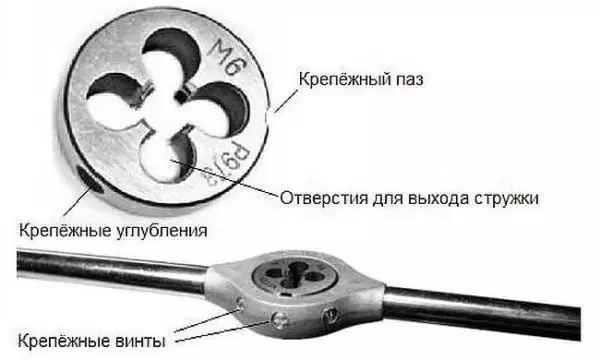
Tool for work
Preparation
It is necessary to work on the pure metal - remove rust, sand and other pollution. Then the place where the thread will be applied, it is necessary to lubricate (except for cast iron and bronze - with them you need to work "on dry"). For lubrication there is a special emulsion, but if it is not, you can use the operated soap. You can also use other lubricants:
- Linen oil for steel and brass;
- Copper turpentine;
- Kerosene - for aluminum.
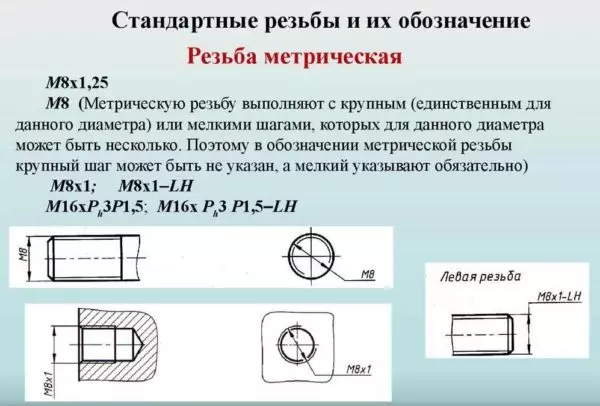
Parameters of metric thread
Often you can hear the tips to use with a carving machine or mineral oil or even fat. They work well, but experts say that it is better not to do - chips will stick to a viscous substance, which will lead to a rapid wear of the tap or dice.
The process of cutting
When cutting out the outer thread, the cry placed strictly perpendicular to the surface of the pipe or rod. When working, it should not vive, otherwise the turns will turn out uneven and the connection will be ugly and unreliable. The first turns are especially important. From how they are "lying" depends on the connection with the distortion.
Applying internal threads, the detail is fixed motionless. If it is a small piece, it can be clamped in vice. If a large plate is to provide its fixedness by available methods, for example, by fixing the bars. M.
The tap in the hole is inserted so that its axis is parallel to the axis of the opening. With a little effort, little by little, begin to twist in a given direction. As soon as you feel that resistance has intensified, unscrew the tap back and clean it from chips. After cleaning, the process continues.
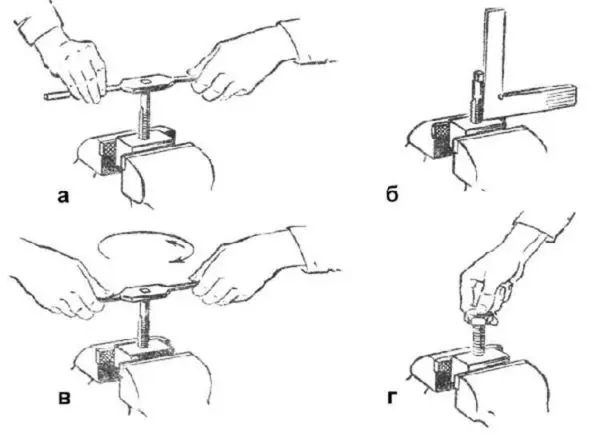
The process of cutting in the photo
When cutting the thread in the deaf hole, its depth should be a little more required - the tip of the tip should be included in this surplus. If it is not possible that it is impossible, the tip is cut at the tip. At the same time, it is not suitable for further operation, but there is no other way out.
In order for the turns to be high-quality, use two taps or dies - rough and finite. The first pass is made by Chernovaya, the second - clean. Also there are combined devices for carvings. They allow you to do everything in one pass.
Another practical advice: so that the chips do not get into the working area, when cutting one full turn clockwise, then floor turns against. After that, they return the tool to the place where they stopped and again make one turn. So continue to the desired length.
Drill Drill Diameter Tables for Threads
When performing the inner thread, the hole is previously drilled. It is not equal to the diameter of the thread, since when cutting, part of the material is not removed as chips, and extruded, increasing the size of the protrusions. Therefore, before applying, you need to select the diameter of the drill drill. This can be done on tables. They are for each type of thread, but we give the most popular - metric, inch, pipe.| Metric carving | Inch thread | Pipe thread | |||||
|---|---|---|---|---|---|---|---|
| Thread diameter, inches | Thread step, mm | Drill diameter, mm | Thread diameter, inches | Thread step, mm | Drill diameter, mm | Thread diameter, inches | Hole diameter for threads, mm |
| M1. | 0.25 | 0.75 | 3/16 | 1.058. | 3.6. | 1/8. | 8.8. |
| M1,4 | 0,3. | 1,1 | 1/4 | 1.270 | 5.0 | 1/4 | 11.7 |
| M1.7. | 0.35 | 1,3 | 5/16. | 1.411 | 6.4. | 3/8 | 15,2 |
| M2. | 0.4. | 1,6 | 3/8 | 1.588. | 7.8. | 1/2 | 18.6 |
| M2.6. | 0.4. | 2,2 | 7/16 | 1.814. | 9.2. | 3/4 | 24.3 |
| M3. | 0.5. | 2.5 | 1/2 | 2,117 | 10.4 | one | 30.5 |
| M3.5 | 0,6 | 2.8. | 9/16 | 2,117 | 11.8. | — | — |
| M4. | 0,7. | 3,3. | 5/8. | 2.309. | 13.3 | 11/4 | 39,2 |
| M5. | 0.8. | 4,2 | 3/4 | 2,540. | 16,3. | 13/8. | 41.6 |
| M6. | 1.0 | 5.0 | 7/8 | 2,822. | 19,1 | 11/2. | 45,1 |
| M8. | 1.25. | 6,75 | one | 3,175 | 21.3. | — | — |
| M10 | 1.5 | 8.5 | 11/8. | 3,629 | 24.6 | — | — |
| M12. | 1.75 | 10.25 | 11/4 | 3,629 | 27.6 | — | — |
| M14. | 2.0 | 11.5. | 13/8 | 4,233 | 30,1 | — | — |
| M16. | 2.0 | 13.5 | — | — | — | — | — |
| M18. | 2.5 | 15.25 | 11/2. | 4,33. | 33.2 | — | — |
| M20. | 2.5 | 17,25 | 15/8. | 6,080 | 35.2 | — | — |
| M22. | 2.6 | nineteen | 13/4 | 5,080 | 34.0. | — | — |
| M24. | 3.0 | 20.5 | 17/8. | 5,644. | 41,1 | — | — |
Once again we draw your attention that the diameter of the drill drill is given for a large (standard thread).
Table of rod diameters for external thread
When working in the outer thread, the situation is very similar - the metal is extruded, and not cut. Therefore, the diameter of the rod or pipe to which the thread is applied, should be slightly smaller. How accurate - see the table below.
| Diameter of thread, mm | 5.0 | 6. | eight | 10 | 12 | sixteen | twenty | 24. |
|---|---|---|---|---|---|---|---|---|
| Rod diameter, mm | 4.92 | 5,92 | 7.9 | 9.9 | 11.88. | 15,88. | 19,86. | 23,86. |
Article on the topic: Kitchen Fan for Hood
